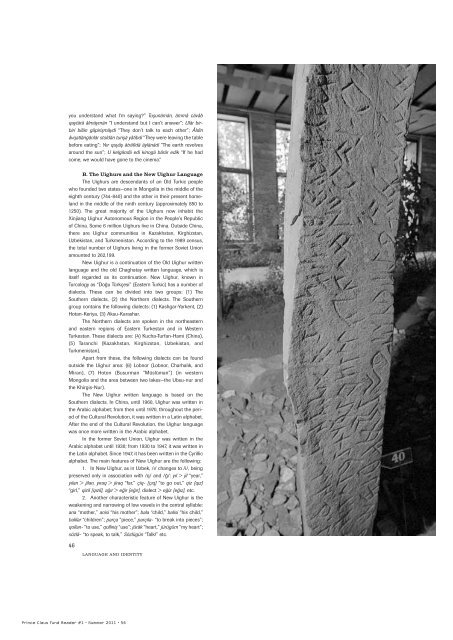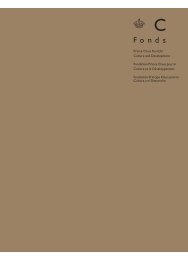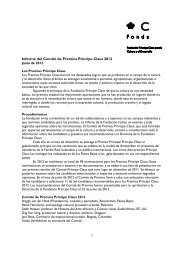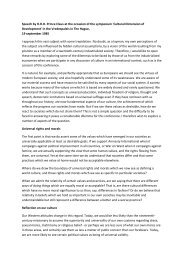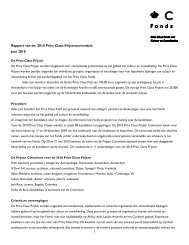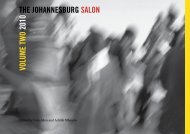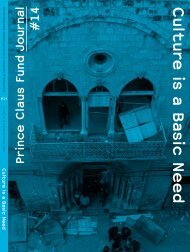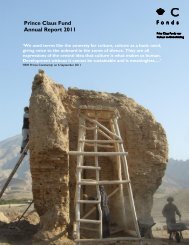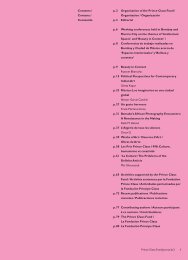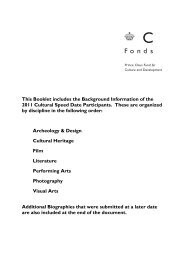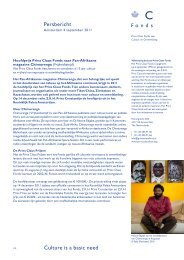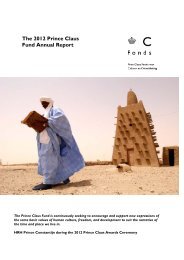030–053talattekin_alt:turklergaram 29.11.2007 9:22 Uhr Seite 46you understand what I’m saying?” Tuşunämän, ämmå cävåbqaytärä ålmäymän “I understand but I can’t answer”; Ulär birbiribilän gäpirişmäydi “They don’t talk to each other”; Åldinåvqatlängänlär stoldän turişä yåtibdi “They were leaving the tablebefore eating”; Yer quyåş ätråfidä äylänädi “The earth revolvesaround the sun”; U kelgändä edi kinogä bårär edik “If he hadcome, we would have gone to the cinema.”B. The Uighurs and the New Uighur LanguageThe Uighurs are descendants of an Old Turkic peoplewho founded two states—one in Mongolia in the middle of theeighth century (744-840) and the other in their present homelandin the middle of the ninth century (approximately 850 to1250). The great majority of the Uighurs now inhabit theXinjiang Uighur Autonomous Region in the People’s Republicof China. Some 6 million Uighurs live in China. Outside China,there are Uighur communities in Kazakhstan, Kirghizstan,Uzbekistan, and Turkmenistan. According to the 1989 census,the total number of Uighurs living in the former Soviet Unionamounted to 262,199.New Uighur is a continuation of the Old Uighur writtenlanguage and the old Chaghatay written language, which isitself regarded as its continuation. New Uighur, known inTurcology as “Do€u Türkçesi” (Eastern Turkic) has a number ofdialects. These can be divided into two groups: (1) TheSouthern dialects, (2) the Northern dialects. The Southerngroup contains the following dialects: (1) Kashgar-Yarkent, (2)Hotan-Keriya, (3) Aksu-Karashar.The Northern dialects are spoken in the northeasternand eastern regions of Eastern Turkestan and in WesternTurkestan. These dialects are: (4) Kucha-Turfan-Hami (China),(5) Taranchi (Kazakhstan, Kirghizstan, Uzbekistan, andTurkmenistan).Apart from these, the following dialects can be foundoutside the Uighur area: (6) Lobnor (Lobnor, Charhal›k, andMiran), (7) Hoton (Busurman “Müslüman”) (in westernMongolia and the area between two lakes—the Ubsu-nur andthe Khirgis-Nur).The New Uighur written language is based on theSouthern dialects. In China, until 1960, Uighur was written inthe Arabic alphabet; from then until 1970, throughout the periodof the Cultural Revolution, it was written in a Latin alphabet.After the end of the Cultural Revolution, the Uighur languagewas once more written in the Arabic alphabet.In the former Soviet Union, Uighur was written in theArabic alphabet until 1930; from 1930 to 1947, it was written inthe Latin alphabet. Since 1947, it has been written in the Cyrillicalphabet. The main features of New Uighur are the following:1. In New Uighur, as in Uzbek, /›/ changes to /i/, beingpreserved only in association with /q/ and /€/: yıl > jil “year,”yılan > jilan, yıraq > jiraq “far,” çiq- [çıq] “to go out,” qiz [qız]“girl,” qizil [qızil], ağır > eğir [eğır], dialect > eğiz [eğız], etc.2. Another characteristic feature of New Uighur is theweakening and narrowing of low vowels in the central syllable:ana “mother,” anisi “his mother”; bala “child,” balisi “his child,”balilar “children”; parça “piece,” parçila- “to break into pieces”;qollan- “to use,” qolliniş “use”; jüräk “heart,” jürügüm “my heart”;sözlä- “to speak, to talk,” Sözlügün “Talk!” etc.46LANGUAGE AND IDENTITY<strong>Prince</strong> <strong>Claus</strong> <strong>Fund</strong> Reader #1 · Summer <strong>2011</strong> · 56
030–053talattekin_alt:turklergaram 29.11.2007 9:22 Uhr Seite 47Yenisei inscriptions,sixth century, MinusinskMuseum, Minusinsk,Russia.3. Another of the main features of New Uighur is thepreservation of the initial /a€/: ağri- “to ache,” bağ, tağ, yağ-,etc.4. The closed /e/ is preserved in an open first syllable:e:di > egä “owner,” ke:çä > keçä “evening, night,” ke:din > keyin“then, later,” etc.5. On the other hand, the closed /e/ in a first syllableclosed by a consonant changes to open /e/: be:r- > bär- “togive,” be:ş > bäş “five,” e:rtä > ärtä “early,” ke:t- > kät- “to go,”ye:ti > yättä “seven,” etc.6. Very important features of New Uighur are theregressive vowel assimilations. These assimilations are of twotypes:(a) The initial /a/and /ä/ in an open first syllable changeto closed /e/ under the influence of an /i/ in the second syllable:arığ > eriq “clean,” ba:lıq > beliq “fish,” sa:rığ > seriq “yellow,”at+i > eti “his horse,” baş+i > beşi “his head,” qaş+i > qeşi“in front of him,” är+i > eri “her husband,” ät+i > eti “his meat,”etc.(b) The initial /a/ and /ä/ are rounded to /o/ and /ö/under the influence of the rounded /u/ and /ü/ in the secondsyllable: açuq > oçuq “open,” a:ruq > oruq “tired,” yaruq > yoruq“light,” ä:tük > ötük “boots,” tämür > tömür “iron,” täşük > töşük“hole,” etc.7. One of the most important features of New Uighur isthe change of /€/ and /g/ at the end of multisyllabic words, asin Uzbek, to /q/ and /k/: ta:ğlığ > tağliq “mountaineer,” atlığ >atliq “cavalryman,” a:tlığ > atliq “famous,” bilig > bilik “knowledge,”ölüg < ölük “dead,” ti:rig > tirik “alive,” etc.8. A principal feature of New Uighur is the disappearance,as in Uzbek, of the pronominal /n/: orun “place,” orn-i-ga“instead of,” öy-i-gä “to his house,” otturu-si-da “in the middle,”üst-i-din “over,” etc.9. The change of the initial /y/ sound to /j/ before thevowels /i, u, ü/ is one of the most characteristic features of NewUighur: yığla- > jiğla- “to cry,” yıl > jil “year,” yılan > jilan “snake,”yipäk > jipäk “silk,” yu:- > juy- “to wash,” yurt > jurt, yügür- >jügür- “to run,” yüräk > jüräk, yüt- > jüt- “to disappear,” etc.A few sentences in New Uighur: Adättikigä qarigandabügün köpräk işliduq “Today we worked harder than ever”; Pulnipoçta arqiliq äwättim “I sent the money by mail”; Uningga qarigandabu ärzänraq ämäs mu? “Looking at it, isn’t it cheaper?”Bizning tehi ügünüşimiz keräk “There is more we have to learn”;Siz bilän hoşlaşqini käldim “I have come to say good-bye”; Mänhär yäkşänbä küni teatrga baridiganmän “I go to the theatreevery Sunday.”IV. to:lu: GROUPThe Kirghiz and Their LanguageThe Kirghiz are a Turkic people whose name frequentlyappears on the Orkhon inscriptions. In 840, the Kirghiz—whobefore the eighth century had been in frequent warfare with theTurks and later with the Uighurs—put an end to Uighur hegemonyin Mongolia and established their own hegemony overthe Mongolia steppes (840-924). After this relatively short periodof independence, they and other “forest peoples” cameunder Mongol rule in 1207. As a result of the great rebellionsbetween 1254 and 1270, some of the Kirghiz were forced tomigrate to Manchuria (1293). When the Russians arrived in theYenisei,-Abakan region at the beginning of the seventeenthcentury, they found four Kirghiz principalities. In the second halfof the seventeenth century, the Yenisei, Kirghiz were obliged toaccept Kalmuk rule. At the beginning of the eighteenth century,the great majority of the Kirghiz migrated to their presentdayhomeland in the Tian Shan region.According to the inscriptions, at the beginning of theeighth century the first Kirghiz homeland was located to thenorth of the Kögmen (Sayan) Mountains. The runic Yenisei,inscriptions found along the upper basin of the Yenisei, Riverare thought to belong to leaders of the Kirghiz tribe. The greatmajority of the Kirghiz now live in the Republic of Kirghizstan.There are also Kirghiz communities in Uzbekistan andTajikistan, northern Afghanistan, Pakistan, and in the XinjiangUighur Autonomous Region in the People’s Republic of China.According to the 1989 census results, there were 2,530,998Kirghiz in the former Soviet Union. The number of Kirghiz andKirghiz speakers in other countries amounts to 3 to 3.5 million.The Kirghiz are Sunni Muslims. Kirghiz emerged as a writtenlanguage following the Soviet revolution. From 1924 to 1926, itwas written in the Arabic alphabet and from 1928 to 1940 in aLatin alphabet. Since 1940, it has been written in a Cyrillicalphabet. The characteristic features of Kirghiz are as follows:1. One of the principal features of Kirghiz is the creationof very long vowels as a result of the contraction of soundgroups such as ağ, aw, ağı, ağu, oğ, oğu, uğ: tağ > to: “mountain,”tağlığ > to:lu: “mountaineer,” bağ > bo:, bağır > bo:r“liver,” ağır < o:r, dialect > o:z, yağı > co: “enemy,” buzağu kıro: “rime,” birägü > birö: “anybody,”küdägü > küyö: “groom,” etc.2. Apart from these secondary long vowels in Kirghiz,there are also a number of primary long vowels in certainwords: a:rı “bee,” ba:rı “all,” ya: > ca: “arrow,” yu:- > cu:- “towash,” etc.3. In Kirghiz, the initial /y/ changes to /c/: yaş > caş“young,” yığ- > cıy-, yıl > cıl, yel > cel, yol > col, yigit > cigit“young,” yigirmä > cıyırma “twenty,” etc.4. One of the most important features of Kirghiz is theoccurrence of labial attraction in this language. This results inthe rounding of /a/ and /ä/ following /o, ö, and ü/: yol-lar >coldor, yol-lar-da > coldordo, köl-lär > köldör, köl-lär-dän >köldördön, korkak > korkok, yüräk > cürök, yüräk-lär > cüröktör,yüräk-lär-dä > cüröktördö, etc. There is, however, no roundingin the initial /u/, as in kuçak “embrace,” kulak, etc.5. The labial attraction in Kirghiz is also encountered inAltai, as in: koçkar > koçkor “ram,” köllär > köldör “lakes,” bolgan> bolgon “became,” bolmağan > bolboğon “didn’t become,”körgänlär > körgöndör “ones who saw,” etc.6. The initial long /›/ is diphthongized to /iy/ in certainwords in Kirghiz: kı:kır- > kıykır- “to call,” kı:mıl > kıymıl “movement,”etc.7. Similarly, in Kirghiz, the sound clusters /eg/ and /ig/regularly change to /iy/: beg > biy “Sir, Mr.,” eg- < iy- “to bend,”teg- > tiy- “to touch,” yigrän- > ciyrän- “to be disgusted,” etc.Some sentences in Kirghiz: Men kün sayın erte turamın “Iget up early every day”; Krovatımdı cıynaymın cu:namın “I makemy bed and wash”; Siler caşsıngar, ösösüngör, keleçektin e:siPRESENT-DAY TURKIC PEOPLES AND THEIR LANGUAGES4757 · <strong>Prince</strong> <strong>Claus</strong> <strong>Fund</strong> Reader #3 · Summer <strong>2011</strong>


